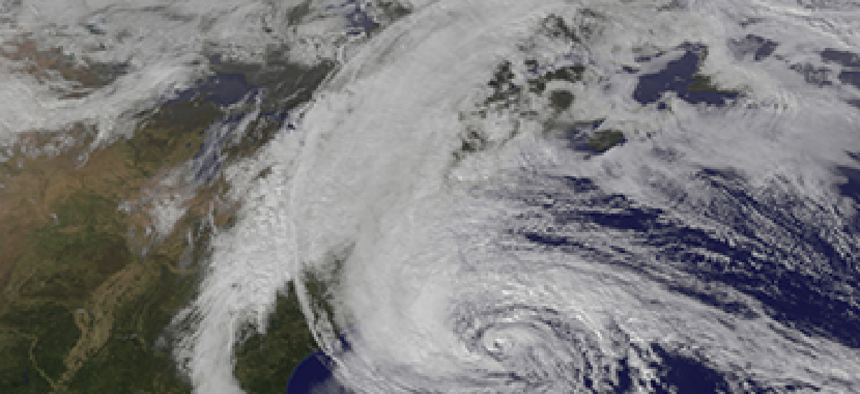NOAA readies a supercomputing boost for hurricane season

With 13 to 20 storms expected, the agency plans a significant improvement in modeling accuracy when new equipment comes online.

Hurricane Sandy as seen from NOAA's GOES-13 satellite on October 28, 2012. (NASA/NOAA photo)
The 2012 hurricane season was one of the worst and costliest on record, but the National Oceanic and Atmospheric Administration predicts the 2013 hurricane season could be even worse.
For the six-month swing beginning June 1, when conditions are ripe for hurricane formation, NOAA's Climate Prediction Center forecasts an active to extremely active season, with a 70 percent likelihood of 13-20 named storms – those that produce winds 39 miles per hour or faster. It calls for up to 11 hurricanes, three to six of which classified as major hurricanes with winds 111 miles per hour or faster.
For perspective, 2012's hurricane season produced 19 named storms that caused upwards of $80 billion in damage, including Hurricane Sandy's $75 billion demolition job on the east coast.
"NOAA predicts an above normal and possibly an extremely active hurricane season with a range of 13 to 20 named storms," seven to 11 of which are forecast to turn into hurricanes and three to six of which are forecast to turn into major hurricanes, said Kathryn Sullivan, acting NOAA administrator.
NOAA's hurricane outlook does not predict how many storms will make landfall.
Individual storm forecasts are conducted by NOAA's National Hurricane Center. It uses a Hurricane Weather Research and Forecasting (HWRF) model, centered on a supercomputer that analyzes data sets collected from satellites, weather buoys and airborne observations from Gulfstream-IV and P-3 jets and churns out high-resolution computer-modeled forecasts.
In July, NOAA's hurricane forecasts will get a boost when a new supercomputer is brought online – it will run an upgraded HWFR that NOAA officials say will improve forecast models "10 to 15 percent."
In addition, Congress has approved $23.7 million in funds directed to the NOAA-housed National Weather Service to beef up its forecasting and supercomputer infrastructure through the Disaster Relief Appropriations Act, also called the Sandy supplemental.
The money will significantly upgrade the Reston, Va.-based supercomputer named Tide that runs the NWS' Global Forecast System (GFS).
GFS' long-term forecasts of Hurricane Sandy were significantly bested by those made by the England-based European Centre for Medium Range Forecasting (ECMWF) model last year, drawing significant criticism from American weather experts and putting the national model a distant second to ECMWF in worldwide forecasting supremacy.
The appropriation allows NWS to boost the computational power behind the GFS model by more than ten times, from 213 teraflops to 2,600 teraflops by fiscal 2015. If those numbers hold as expected, they would surpass ECMWF the same year.
Increased computational capacity translates to higher resolution models of existing data from sources like weather satellites, which ultimately helps forecasters pick up on potentially minute changes in conditions that can change the way a storm system behaves.
Given the increased frequency of extreme weather in recent years, and NOAA's forecast for another hurricane-laden year, infrastructure investments in weather prediction will have plenty of chances to prove their value.



